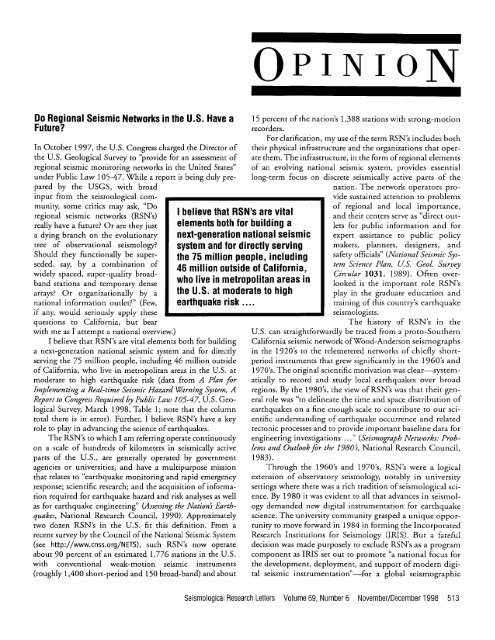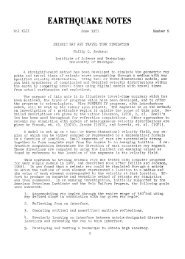OPINION - Seismological Research Letters
OPINION - Seismological Research Letters
OPINION - Seismological Research Letters
You also want an ePaper? Increase the reach of your titles
YUMPU automatically turns print PDFs into web optimized ePapers that Google loves.
<strong>OPINION</strong><br />
Do Regional Seismic Networks in the U.S. Have a<br />
Future<br />
In October 1997, the U.S. Congress charged the Director of<br />
the U.S. Geological Survey to "provide for an assessment of<br />
regional seismic monitoring networks in the United States"<br />
under Public Law 105-47. While a report is being duly prepared<br />
by the USGS, with broad<br />
input from the seismological com-<br />
munity, some critics may ask, "Do<br />
regional seismic networks (RSN's)<br />
really have a future Or are they just<br />
a dying branch on the evolutionary<br />
tree of observational seismology<br />
Should they functionally be superseded,<br />
say, by a combination of<br />
widely spaced, super-quality broadband<br />
stations and temporary dense<br />
arrays Or organizationally by a<br />
national information outlet" (Few,<br />
if any, would seriously apply these<br />
questions to California, but bear<br />
with me as I attempt a national overview.)<br />
I believe that RSN's are vital elements both for building<br />
a next-generation national seismic system and for directly<br />
serving the 75 million people, including 46 million outside<br />
of California, who live in metropolitan areas in the U.S. at<br />
moderate to high earthquake risk (data from A Plan far<br />
Implementing a Real-time Seismic Hazard Warning System, A<br />
Report to Congress Required by Public Law 105-47, U.S. Geological<br />
Survey, March 1998, Table 1; note that the column<br />
total there is in error). Further, I believe RSN's have a key<br />
role to play in advancing the science of earthquakes.<br />
The RSN's to which I am referring operate continuously<br />
on a scale of hundreds of kilometers in seismically active<br />
parts of the U.S., are generally operated by government<br />
agencies or universities, and have a multipurpose mission<br />
that relates to "earthquake monitoring and rapid emergency<br />
response; scientific research; and the acquisition of information<br />
required for earthquake hazard and risk analyses as well<br />
as for earthquake engineering" (Assessing the Nation's Earthquakes,<br />
National <strong>Research</strong> Council, 1990). Approximately<br />
two dozen RSN's in the U.S. fit this definition. From a<br />
recent survey by the Council of the National Seismic System<br />
(see http://www.cnss.org/NETS), such RSN's now operate<br />
about 90 percent of an estimated 1,776 stations in the U.S.<br />
with conventional weak-motion seismic instruments<br />
(roughly t ,400 short-period and 150 broad-band) and about<br />
I believe that RSN's are vital<br />
elements both for building a<br />
next-generation national seismic<br />
system and for directly serving<br />
the 75 million people, including<br />
46 million outside of California,<br />
who live in metropolitan areas in<br />
the U.S. at moderate to high<br />
earthquake risk ....<br />
15 percent of the nation's 1,388 stations with strong-motion<br />
recorders.<br />
For clarification, my use of the term RSN's includes both<br />
their physical infrastructure and the organizations that operate<br />
them. The infrastructure, in the form of regional elements<br />
of an evolving national seismic system, provides essential<br />
long-term focus on discrete seismically active parts of the<br />
nation. The network operators provide<br />
sustained attention to problems<br />
of regional and local importance,<br />
and their centers serve as "direct outlets<br />
for public information and for<br />
expert assistance to public policy<br />
makers, planners, designers, and<br />
safety officials" (National Seismic System<br />
Science Plan, U.S. Geol. Survey<br />
Circular 1031, 1989). Often overlooked<br />
is the important role RSN's<br />
play in the graduate education and<br />
training of this country's earthquake<br />
seismologists.<br />
The history of RSN's in the<br />
U.S. can straightforwardly be traced from a proto-Southern<br />
California seismic network of Wood-Anderson seismographs<br />
in the 1920's to the telemetered networks of chiefly shortperiod<br />
instruments that grew significantly in the 1960's and<br />
1970's. The original scientific motivation was clear--systematically<br />
to record and study local earthquakes over broad<br />
regions. By the 1980's, the view of RSN's was that their general<br />
role was "to delineate the time and space distribution of<br />
earthquakes on a fine enough scale to contribute to our scientific<br />
understanding of earthquake occurrence and related<br />
tectonic processes and to provide important baseline data for<br />
engineering investigations ..." (Seismograph Networks: Problems<br />
and Outlook far the 1980'S, National <strong>Research</strong> Council,<br />
1983).<br />
Through the 1960's and 1970's, RSN's were a logical<br />
extension of observatory seismology, notably in university<br />
settings where there was a rich tradition of seismological science.<br />
By 1980 it was evident to all that advances in seismology<br />
demanded new digital instrumentation for earthquake<br />
science. The university community grasped a unique opportunity<br />
to move forward in 1984 in forming the Incorporated<br />
<strong>Research</strong> Institutions for Seismology (IRIS). But a fateful<br />
decision was made purposely to exclude RSN's as a program<br />
component as IRIS set out to promote "a national focus for<br />
the development, deployment, and support of modern digital<br />
seismic instrumentation"--for a global seismographic<br />
<strong>Seismological</strong> <strong>Research</strong> <strong>Letters</strong> Volume 69, Number6 November/December 1998 513
network and for array seismic studies of the continental<br />
lithosphere.<br />
One legacy of this action, which still affects earthquake<br />
seismology in the U.S., is the dynamics of what can be called<br />
an IRIS-NSF arena vis-a-vis a USGS-NEHRP arena, In<br />
1984, university RSN'S were left squarely in the latter, and<br />
the majority of them became doubly disadvantaged, first by<br />
years of no-growth or reduced NEHRP funding and second<br />
by NSF program directions and influences on funding that<br />
(a) effectively handicapped attempts by RSN researchers to<br />
get NSF grants for network-related science and (b) generally<br />
precluded help to RSN'S from NSF in improving instrumentation.<br />
Since the mid-1980's, RSN's<br />
have been seriously strained to meet<br />
the simultaneous challenges of modernization<br />
(if not sheer survival),<br />
increased expectations to meet practical<br />
user needs for public safety and<br />
earthquake loss reduction, delivery<br />
of all data into an open information<br />
system for community use, and scientific<br />
research. Present support for<br />
university network seismologists to<br />
perform many basic RSN functions<br />
depends unstably on competition<br />
for research funding, separate from<br />
operational funding. Some may reason<br />
that Darwinian survival of<br />
RSN's is appropriate, but this begs the question of how the<br />
real needs of populations at risk in the affected regions are to<br />
be met. (Recall the 46 million outside of California.)<br />
H. Rishbeth and others, writing in a 1993 article in Eos<br />
on long-term solar-terrestrial monitoring, wrote: "Monitoring<br />
programs are often undervalued because of a false view<br />
that they have little to do with innovative research. In reality,<br />
the data derived from long-term monitoring operations<br />
often add to new scientific results and underpin other<br />
research." In a related vein, R. L. Vogel observed in a recent<br />
1998 issue of Eos that "making data available for interdisciplinary<br />
or future uses has not traditionally been a valued<br />
activity in the scientific community." He goes on to say,<br />
"The information revolution is causing the values of the scientific<br />
community to be assessed." In the July/August 1998<br />
issue of Seisrnological<strong>Research</strong> <strong>Letters</strong>, Lowell Whiteside made<br />
the point that "It]he history of science shows that great<br />
breakthroughs occur when new tools are combined with<br />
available data and innovative scientific thinking." What data<br />
will be valuable fifty years from now Fundamental data for<br />
advancing the science of earthquakes surely must include<br />
continuous temporal monitoring of key source zones from<br />
the microearthquake level (below magnitude 3) to the level<br />
of strong motion. Continuity of data, which may become<br />
critical to earthquake forecasting or prediction, cannot be<br />
provided by temporary dense arrays. And widely spaced<br />
broad-band stations cannot yield either a sufficiently low<br />
magnitude threshold of space-time sampling or data needed<br />
Decades of struggling to establish<br />
stable support for national and<br />
regional seismic monitoring, as<br />
well as strong-motion recording,<br />
could be decisively resolved by<br />
persuading Congress to recognize<br />
the fundamental importance of a<br />
national seismic system and to<br />
finance it under a line-item<br />
appropriation.<br />
514 <strong>Seismological</strong> <strong>Research</strong> <strong>Letters</strong> Volume 69, Number6 November/December1998<br />
for advancing our understanding of main-shock ground<br />
motions in extensional and intraplate regions.<br />
The importance of continuously monitoring specific<br />
seismic source zones in detail sensibly varies according to<br />
hazard and risk, but balanced nationwide attention is essential<br />
because risk is markedly increasing in many regions.<br />
Consider Utah's densely populated Wasatch Front area,<br />
where more than three quarters of the state's population and<br />
economy literally sits astride the most active segments of the<br />
Wasatch Fault. Population in this dramatically growing megalopolis<br />
is projected to increase from a 1995 base of 1.6 million<br />
to 2.7 million by 2020 and to 5 million by 2050. Many<br />
other areas warrant similar concern,<br />
such as San Juan, Puerto Rico, and<br />
Las Vegas, Nevada, the fastest growing<br />
metropolis in the U.S.<br />
My experience tells me that--<br />
like politics and history--earthquake<br />
problems are ultimately<br />
"local", and the social dynamics<br />
vary widely. How user needs are<br />
defined and served in California<br />
may not be a desirable or cost-effective<br />
model for Alaska, Montana, or<br />
New England. RSN's have played an<br />
important role historically, especially<br />
in regions of moderate to low<br />
seismicity, in creating public awareness<br />
of earthquake dangers and in marshaling much of the<br />
relevant information to deal with those dangers. This special<br />
attunement to region-specific earthquake problems and<br />
social dynamics leads me to believe that RSN's have a unique<br />
potential in the seismological community to meet long-term<br />
user needs, on a region-by-region basis, for earthquake data,<br />
information (what users want or need to know), and related<br />
services. Anyone who has ever worked in a regional network<br />
center understands that RSN's are where "the rubber hits the<br />
road" when it comes to "societally relevant" earthquake seismology.<br />
Where do we go from here I see at least three possibilities<br />
for major progress in dealing with the issues I have<br />
raised: (1) creation of a next-generation national seismic system,<br />
(2) securing congressional line-item funding for ongoing<br />
operation of such a system, and (3) promoting better<br />
synergy between the USGS-NEHRP arena and the IRIS-<br />
NSF arena.<br />
Since 1993 there has been clear progress in creating<br />
what I will call a first-generation national seismic system by<br />
integrating RSN's with the U.S. National Seismograph Network.<br />
This system is inherently cooperative, muhijurisdictional,<br />
and with resources unevenly spread. In my view, the<br />
challenge is to take a systems engineering approach to create<br />
the physical and informational infrastructure of a new technologically<br />
advanced national seismic system, consisting of<br />
national, regional, and local elements. The process now<br />
underway of writing the report to Congress on seismic mon-
itoring in the U.S. that I referred to in my first paragraph has<br />
brought seismologists and earthquake engineers together in<br />
an unprecedented way to create a vision of such a next-generation<br />
national seismic system. The vision combines integrated<br />
seismographic monitoring on national, regional, and<br />
local scales with strong-motion recording and structuralresponse<br />
monitoring focused on urban areas at risk. It<br />
emphasizes services and information products, including<br />
rapid and timely information for emergency management.<br />
The evolution of real-time earthquake information systems<br />
and the great practical value of rapidly broadcasting maps of<br />
actual ground shaking have created a powerful new flamework<br />
for unifying strong- and weak-motion recording for<br />
emergency management, engineering, and science.<br />
In the report Assessing the Nation's Earthquakes (National<br />
<strong>Research</strong> Council, 1990), the foremost recommendation was<br />
that "[t]he federal government should establish a more rational,<br />
coordinated, and stable means of support for the seismic<br />
networks of the United States .... "The most effective way to<br />
do this, it seems to me, would be through congressional lineitem<br />
funding for a national seismic system of the type<br />
described above. For decades, the existence of infrastructure<br />
for fine-scale regional monitoring in the U.S. has depended<br />
on the sacrifices and career-long dedication of key individuals.<br />
I do not think this framework is sustainable. Nor do I<br />
think this burden should be perpetuated for future generations<br />
of seismologists. Decades of struggling to establish stable<br />
support for national and regional seismic monitoring, as<br />
well as strong-motion recording, could be decisively resolved<br />
by persuading Congress to recognize the fundamental<br />
importance of a national seismic system and to finance it<br />
under a line-item appropriation.<br />
Finally, what about synergy between the USGS-<br />
NEHRP and IRIS-NSF arenas The seismological commu-<br />
nity is not immune from internal tensions, some of which<br />
are implicit, for example, in Tom Jordan's opinion piece in<br />
the January/February 1997 issue of <strong>Seismological</strong> <strong>Research</strong><br />
<strong>Letters</strong>, in which he took a balanced look at the value of both<br />
applied and basic science in the study of earthquakes. Perhaps<br />
a timely lesson can be drawn from well known observations<br />
of hemispheric differences--and conflicts--in the<br />
human brain. We know that both sides of the brain process<br />
the same information in different ways, that they are motivated<br />
differently, and that one side tends to seek dominance<br />
and inhibit the other. In art and writing, the solution to dealing<br />
with these tensions between the left-brain and rightbrain<br />
lies in recognizing the special capabilities of each side<br />
and in finessing a complementary division of labor. (See, for<br />
example, Gabriele Lusser Rico's book, Writing the Natural<br />
ItPhy, or Betty Edwards' classic text on Drawing on the Right<br />
Side of the Brain.) In helping the nation deal with its earthquake<br />
problems, are there special capabilities on each side<br />
and possibilities for a complementary division of labor<br />
between the USGS-NEHRP arena and the IRIS-NSF arena<br />
I think any outside observer can readily see them. Can we<br />
Peter Bowen, a contemporary Montana writer,<br />
observed: "The cowboy won't ever be replaced--no mere<br />
machine could ever stand the abuse." Will RSN's be<br />
replaced Part of me rushes to say, "Not soon--for the same<br />
reason as cowboys." Another part of me, seeing the vision of<br />
an evolving national seismic system, adds, "No, RSN's have<br />
a unique role to play--and better things are coming." El<br />
Walter A rabasz<br />
Department of Geology and Geophysics<br />
University of Utah<br />
arabasz@seis.utah.edu<br />
<strong>Seismological</strong> <strong>Research</strong> <strong>Letters</strong> Volume 69, Number6 November/December 1998 515
















